Level 3
Unit 78 - Digital Graphics for Computer Games (Part 2)
P1- Understand Theory & Application of Digital Graphics
Computer Game Graphics:
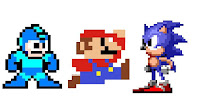 |
| Popular characters using pixel art |
- Pixel Art - Consisting of creating images through a computer using software that can make raster images (this means they can be changed and made pixel by pixel). This method was used way before 3D graphics in games were popular but these creations are still often found in 2D games and on mobiles as they can use two-dimensional art still, giving it back its needed value. Normally stored as GIFs or PNGs. Anything that generates pixel art cannot be defined as pixel art: gradients and anti-alias tools (a sort of a blending tool) etc.
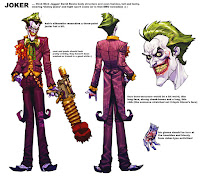 |
| Concept art for the Joker |
- Concept Art - "The main goal of concept art is to convey a visual representation of a design, idea, and/or mood for use in films, video games, animation, or comic books before it is put into the final product." - Creative Bloq Staff. So basically it wants to show the overall design and its effect rather than making everything in its right terms at the beginning. It is key to focus on that exact artistic vision and smooth out any mistakes visually that might be able to create any sort of problem. It can range from mood shots to more detailed things like props or a character. It should reduce error chances therefore, time and cost.
 |
| Texturised wall |
- Texture Art - Its thanks to textural artists that we have the amount of detail we do as they define parts of a 3D computer model. A majority of textures created are used in film, TV shows and video games. They must create photorealistic textures for almost wrapping onto 3D objects used in film, TV shows, video games music videos or commercials (like presents and gift boxes). Most will be started from scratch but they may also be created using existing materials, they should be familiar with the processes of UV mapping. They may scan in photos then apply the textures to what item or environment made by other members of the effects team or create custom textures that are not very close to what happens in nature.
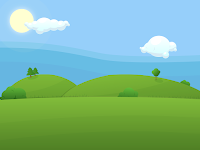 |
| Simple background |
- Background Graphics - Sets the stage for player, also the furthest thing away from the player. It may act as a blank canvas. It may show key elements to a game including hints, tips and where to go next. These tend to be one of the highest quality works of a game, as it can be the focal point of graphics and make the game more interesting for those who enjoy styles like photo realism.
 |
Self edited and analysed User Interface of Uncharted using
Photoshop and a graphics tablet |
- In-game Interface - A display of progress, information and feedback known as the HUD (Head Up Display), this may include: map info, health, ammo, objectives and a signal your health may be at critical. For shooting a gun your target should be in the centre of view and everything should be at a minimal to avoid blind spots and getting in the way. They should always stay in our peripheral vision and stay away from out central vision. A lot of FPS game players will expect things to be in the same place this usually means; "Health on the left and ammo on the right. Maps: Top of the screen out of the way of your target. Inventory/Weapon Choices: Toggled, either approaching from the sides or on top." - Chris Castaldi on Slide Share. Types of interface may include: Buttons (what's available and what to press), Management (group movement, raid interfaces and inventory considering types of a unit), Targeting (current taget and health or other info of the other target), Info (how much of current weapon, durability, ammo, health and inventory), Textual (mostly in MMOs or RPGs, chat, dialog and nameplates) and Navigation (compass, minimaps, world maps and X Marks the spot types). Interfaces should not be big, too full of info, unresponsive, contain too little info, bad fonts, bad colour choices or the incorrect style.
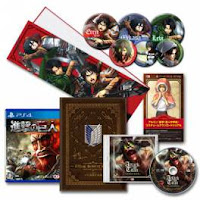 |
| Attack on Titan 'Treasure Box' |
- Print Media Art - This includes posters, box art, packaging, manuals and labels. Its basically anything that is physically printed relating to the game. It is mainly a form of marketing to look appealing enough to draw people in and make them actually want to spend money on the game. This may be achieved by colour use, art styles and techniques, and sometimes in writing and fonts. It must be eye-catching and use focal pointing and other drawing in effects. Without good print media you might not have a game worth enough to others to sell. This Attack on Titan 'Treasure Box' uses print media to not only decorate the games box itself enough for you to want it, but also comes with a mass amount of accessories cleverly designed to attract its audience and buyers. This is all part of the thought out marketing plan.
Types Of Digital Graphics:
- Raster Images - These include: BMP, GIF, TIFF and JPG. They are made of pixels arranged to display an image, each pixel is a different colour. They allow colour editing past that of a Vector image.
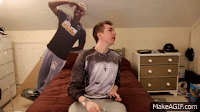 |
| Self made GIF using MakeAGIF.com |
- Vector Images - These include: PSD, WMF, FLA and AI. They are made up of paths with a mathematical formula each that will tell the path on how it should be shaped and what its filled or bordered with. Vector images are scalable so it may be resized to fit anything from a business card to a billboard.
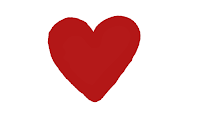 |
| Love heart self made in Photoshop |
- Main Differences - Raster image pixels do not have the same appearance as the size of the image increases. If you were to enlarge a Raster image majorly it would become blurry due to this factor. Vector images do have the same appearance no matter what the size seeing as the mathematical dictate how the image is rendered. Raster are larger files in comparison to Vector files which are small and lightweight.
- What are BMP, GIF, PSD, WWF etc. exactly? -
- BMP - Bitmap image file
- GIF - Graphics Interchange Format
- TIFF - Tagged Image File Format (exchanging BMF images between application programs)
- JPEG (file name extension of JPG) - Joint Photographic Experts Group
- PSD - Photoshop Document
- WMF - Windows Metafile (originally designed for Microsoft Windows in the 1990s)
- FLA - Flash Files (file extension)
- AI - Adobe Illustrator Artwork








No comments:
Post a Comment